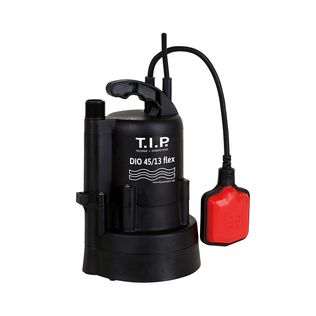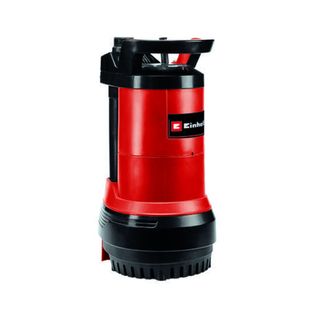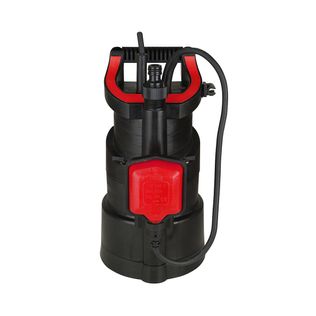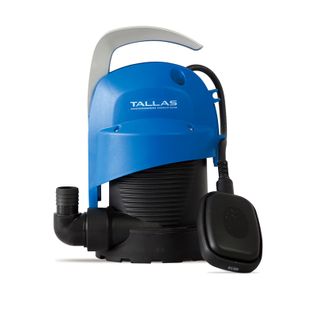Buying a water butt pump
A water butt pump is a smaller submersible pump suitable for rain barrels. The models we provide have a lower pump capacity than regular submersible pumps because the latter are made to discharge large amounts of water within a short time: for instance, in a flooded cellar or basement. The average rain barrel can store about 250 litres of water, and if you place the T.I.P. DrainPress 3200/24 (with a pump capacity of 3,200 litres per hour) in it, its contents will be discharged within five minutes. It is therefore more efficient to use a large barrel.
Please keep in mind that not all rain barrel pumps provide enough pressure to run sprinklers, but in that case you can always water your plants with a garden hose.
How does a water butt pump work?
When looking for a pump to spray your garden, there's really plenty of choice. But water butt pumps are one of a kind, because they mainly provide for people who want to reuse rainwater around the garden and in the backyard, for irrigation or cleaning purposes. At the same time, some water butt pumps can be flexible enough to come in handy for different purposes like dewatering and drainage. Here's how they work.
A water butt pump is an electric pump that works by creating a vacuum that pulls the water up from the bottom of the water butt and pushes it through the hose. When you turn on the pump, the impeller (a rotating component of the pump) draws water through the inlet and expels it through the outlet.
Float
In many cases, a float is connected to the pump, which ensures that the pump switches on and off automatically when the water has reached a certain level. When the water rises, the float does so as well and activates the pump, and drops again when the water level in the rain barrel drops. The pump is deactivated when the original water level has been reached.
Applications of water butt pumps in the garden
Water butt pumps are an excellent choice for gardeners who want to irrigate their plants using rainwater instead of tap water. Rainwater is often rich in nutrients and is free from the chemicals found in tap water, making it an excellent option for plants. Water butt pumps can also be used to fill ponds and water features, wash cars, and clean garden furniture.
How to choose the right water butt pump
When choosing a water butt pump, it is essential to consider the size of your water butt, the type of hose you plan to use, and the water pressure you need for your application. Some pumps are designed to be used with a water butt of a specific size, so it is crucial to check the manufacturer's specifications before making a purchase.
You can find online water pumps with diverse performance capacities in terms of flow rate (capacity) and delivery head, which is the maximum distance at which water can be displaced. Be sure to take a look at the technical information in the products' data sheets.
The power of the pump is also an important consideration. A more powerful pump will be able to deliver water at a higher pressure and through a longer hose. However, more powerful pumps tend to be more expensive, so it is essential to choose a pump that is appropriate for your needs.
Use an appropriate hose
In selecting a water butt pump, it is also important to consider the type and length of the hose you wish to use, because the device should be able to discharge the water effortlessly. If the hose is too narrow, the pump will experience too much resistance, making it difficult to transfer water. It is therefore advisable to determine the required hose diameter beforehand, and to check whether the pump is able to operate effectively with this size. Make sure the pump you choose is geared to the length as well as the diameter of the hose you use, or buy a new garden hose.
Avoiding issues with your water butt pump
A common problem with water butt pumps is a jamming impeller, the rotating part that transfers water through the pump. If the rain barrel contains dirt or rubble and it enters the pump, this may block the impeller and prevent the pump from delivering the performance expected of it. It is therefore essential to clean the rain barrel regularly and check it for leaves, twigs, and other matter. If possible, also use a filter or strainer to prevent large particles from entering the pump. Regular maintenance and cleaning not only reduces the risk of damage but extends the life of the water butt pump and ensures that it will run optimally.
Storing a water butt pump
When the summer season is over and it is no longer necessary to water the garden, the pump should be cleaned thoroughly and inspected for signs of damage and wear. Remove any dirt that may be stuck in the pump and pipes, and dry the cleaned pump completely before storing it. Store it somewhere dry and free of frost, for example in a shed or garage, in order to prevent damage due to moisture and low temperatures. If the pump is well maintained and stored properly, it will be ready for use at the start of the new gardening season.
Pump for a rainwater tank
You may have a large tank and be looking for a rainwater pump to use its contents for applications in and around the house: for example, to flush a toilet, spray down the patio, or even run the washing machine. In such situations, a water butt pump is not powerful enough, and you will need a water pump specifically for a rainwater tank. This pump generates high pressure and can supply water to multiple applications at the same time. Furthermore, the pump will switch on and off automatically, depending on the amount of water required. Every time a tap is turned on, the pump switches on, increasing the water pressure. It switches off when the tap is turned off.










